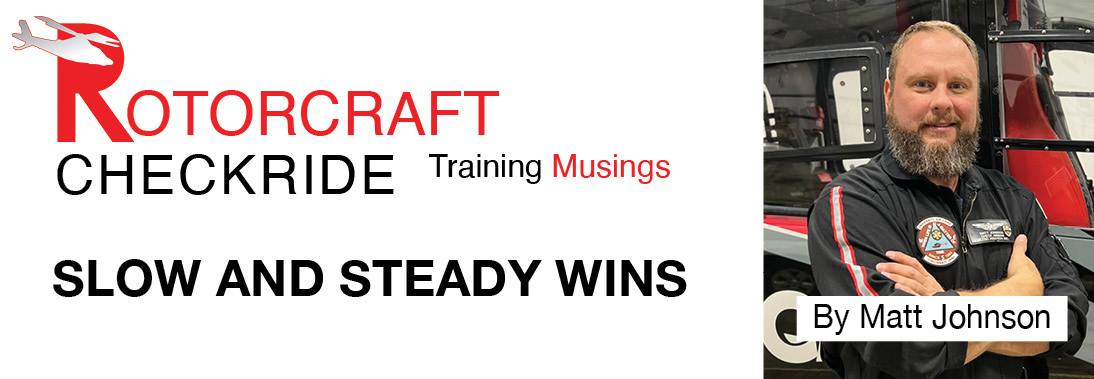|
Nov
10
2025
|
|
Posted 41 days ago ago by Admin
|
|

Like the fabled turtle, slow and steady will help you “win” when it comes to successful hovering! What is successful hovering? In my view, it’s precision hovering, and it’s an absolute must-have skill that often degrades for various reasons throughout a student's training and even throughout a professional pilot's career.
It is one of the more difficult things until you finally get it, but once you learn to hover a helicopter, it is hard to describe the level of accomplishment you feel.
Unfortunately, by the time the student gets the hang of it, they are often saturated with learning so many other necessary skills that continued hovering performance and improvement become stagnant. Instructors and students alike should strive to overcome the tendency to cram too many things into a lesson without spending the necessary time to refine the hover skillset continually. But don’t take my word for it! In the accident database, you will find an assortment of “Loss of Control” (LOC) accidents purely related to and occurring either in the hover (hover taxi included) or in the pick-up to a hover and the landing from the hover. In one recent LOC accident, a pilot landed, his last passengers of the day had disembarked, followed by an attempted pick-up and departure. However, the pilot failed to compensate for the new lateral and longitudinal CG, the pickup wasn’t a slow and deliberate two-stage pick up, and in an instant, the aircraft drifted, hooked a skid, and rolled on its right side in a classic case of Dynamic Rollover.
If we delve into the ACS at the Private Pilot level, we find that there are five specific tasks related to “Hovering Maneuvers” in Section IV. Granted, unless you show up to your test in a helicopter with wheel-type landing gear, you are only tested on four of those tasks. In Task A: “Vertical Takeoff and Landing,” we are provided with all the various Knowledge, Risk Management, and Skills elements for this task. This is where instructors need to place a strong emphasis on Risk Management areas, as they are often the culprits of hover-related LOC incidents and accidents. They include: Loss of tail rotor effectiveness (LTE), Dynamic Rollover, Ground Resonance, etc. The “Skills” section covers eight different areas. For brevity, I’ll only highlight those areas that should be a focus and staple for a portion of every lesson in order to achieve a level of precision hovering. One of the skills states that you must ascend to and maintain the recommended hovering altitude, and descend from the recommended hovering altitude in headwind, crosswind, and tailwind conditions without drift. This is a big one, as you will see that it clearly indicates that a level of precision hovering is expected of you with the wind coming from any direction, and you must do it without DRIFT! You are also expected to maintain your position within 4 feet of a designated point with no AFT movement, all while you maintain a specified heading of ± 10°. If you are going for your commercial certificate, the same is expected of you, except that the tolerances require ever more “precision,” as you are required to “Maintain position within 2 feet of a designated point with no AFT movement.”
The “Hover Taxi” skills area is where we find further proof that our precision hovering skills must be up to par. In this section, we see that the applicant is expected to “Make a 360° pivoting turn, left and right, stopping within 10° of a specified heading.” This skills area is in place for both the Private and Commercial ACS. The skills area ends, again in the Private and Commercial standards with a final task that is somewhat of a “catch-all” when it comes to evaluating an applicants ability to hover with precision where it says that you must “make smooth, timely, and correct control application during the maneuver”.
Wrapping up the “Hovering Maneuvers” area, we find the “Slope Operations” task. It will behoove students and instructors to frequently review this ACS section. However, one needs to go further and review Appendix 3 of the ACS. In this appendix, you will find that we are given guidance in terms of the direction and the magnitude of slopes we must test. The guidance says:
“Demonstration of parallel slope operations must be conducted in accordance with the helicopter manufacturer’s limitations, if published. If no slope limitations are published for the helicopter being used, parallel slope operations of approximately 5-10 degrees may be demonstrated. Landings with the helicopter facing downhill or uphill will not be tested during certification.”
Take the time during each flight to focus on slow and steady precision hovering and win by not becoming another LOC statistic!
READ MORE ROTOR PRO: https://justhelicopters.com/Magazine
WATCH ROTOR PRO YOUTUBE CHANNEL: https://buff.ly/3Md0T3y
You can also find us on
Instagram - https://www.instagram.com/rotorpro1
Facebook - https://www.facebook.com/rotorpro1
Twitter - https://twitter.com/justhelicopters
LinkedIn - https://www.linkedin.com/company/rotorpro1